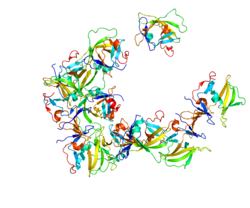RIG-I
| RIG-I | ||
|---|---|---|

|
||
| Representation based on PDB 2QFB | ||
|
Existing structural data : 2LWD , 2LWE , 2QFB , 2QFD , 2RMJ , 2YKG , 3LRN , 3LRR , 3NCU , 3OG8 , 3TMI , 3ZD6 , 3ZD7 , 4AY2 , 4BPB , 4NQK , 4ON9 , 4P4H |
||
| Properties of human protein | ||
| Mass / length primary structure | 925 amino acids | |
| Secondary to quaternary structure | Monomer; Homomultimer after virus contact | |
| Isoforms | 2 | |
| Identifier | ||
| Gene names | DDX58 RIG-I; RIGI; RLR-1; SGMRT2 | |
| External IDs | ||
| Enzyme classification | ||
| EC, category | 3.6.1. , Helicase | |
| Response type | Untwisting double-stranded RNA | |
| Occurrence | ||
| Homology family | DEAD helicopters | |
| Parent taxon | Euteleostomi | |
| Orthologue | ||
| human | House mouse | |
| Entrez | 23586 | 230073 |
| Ensemble | ENSG00000107201 | ENSMUSG00000040296 |
| UniProt | O95786 | Q6Q899 |
| Refseq (mRNA) | NM_014314 | NM_172689 |
| Refseq (protein) | NP_055129 | NP_766277 |
| Gene locus | Chr 9: 32.46 - 32.53 Mb | Chr 4: 40.2 - 40.24 Mb |
| PubMed search | 23586 |
230073
|
RIG-I ( retinoic acid inducible gene I ) is an intracellular receptor belonging to the helicases of the innate immune system of mammals, which plays a central role in the recognition of several RNA viruses (including hepatitis C , influenza ). The natural ligand of RIG-I was only identified in 2006. Single- and double-stranded ribonucleic acids with a triphosphate at the 5 'end are recognized. This triphosphate RNA is generated by viral polymerases and cellular RNA polymerase III.
RIG-I is activated by interferon -α, -β, -γ and bacterial lipopolysaccharides . When the monomer binds to the triphosphate RNA, a conformational change takes place and the receptor multimerizes. The MAVS / IPS1 signal cascade is then triggered, which leads to the activation of NF-κB , IRF3 , IRF7 and the release of antiviral cytokines such as interferon-β and CCR5 .
Web links
- A. Ablasser, F. Bauernfeind, G. Hartmann, E. Latz, KA Fitzgerald, V. Hornung: RIG-I-dependent sensing of poly (dA: dT) through the induction of an RNA polymerase III-transcribed RNA intermediate. In: Nature Immunology . Volume 10, number 10, October 2009, pp. 1065-1072, doi : 10.1038 / ni.1779 , PMID 19609254 , PMC 3878616 (free full text).